At nearly 7,000 m (23,000 ft), Aconcagua is the highest peak outside of Asia and is the highest peak in South America.

At 6,960 meters (22,841 feet), Aconcagua is the highest peak in the Americas and the tallest mountain outside of Asia. Known as "Stone Sentinel," Aconcagua towers over the Andes on the Chile-Argentina border, offering an awe-inspiring challenge for climbers. Surrounded by desert landscapes and high plains, this majestic peak is a popular destination for both novice and experienced climbers, offering a variety of routes to the summit.
The most common route for ascending Mount Aconcagua is the Normal Route. This is a direct ascent with shorter distances and less demanding travel times between camps—typically three to four hours compared to five to seven hours on the more challenging Polish Glacier Traverse Route. The Normal Route is a non-technical climb, making it accessible to climbers with a moderate level of fitness and experience.
Our climbing package includes a well-equipped Base Camp at Confluencia and Plaza de Mulas, where climbers can rest and acclimatize. Additionally, porters are available to assist with carrying group gear, lightening the load on the ascent.
Acclimatization is key, and we incorporate a summit attempt of Mt. Bonete, which takes climbers above 5,000 meters (16,404 feet), ensuring that they are prepared for the altitude of Mt Aconcagua’s summit.
The Polish Glacier Traverse Route offers a more dynamic experience, as climbers circumnavigate the peak, ascending from the east and descending via the Normal Route on the west. This route is more challenging due to longer distances between camps, requiring five to seven hours of climbing compared to the Normal Route’s three to four. However, it rewards climbers with ever-changing views and varied terrain. Like the Normal Route, the Polish Traverse is also non-technical, making it suitable for climbers with proper acclimatization and fitness.
Climbing Aconcagua
is a physically demanding but rewarding expedition. With our expert guides, well-equipped camps, and acclimatization support, climbers are given an excellent chance of reaching the summit. Whether you choose the straightforward Normal Route or the more challenging Polish Glacier Traverse, the journey to the top of Aconcagua promises an unforgettable adventure in one of the most stunning and remote mountain ranges in the world.
If you are looking for answers to specific questions, read here or go here to see
some of our blog posts
Google Earth .KMZ file
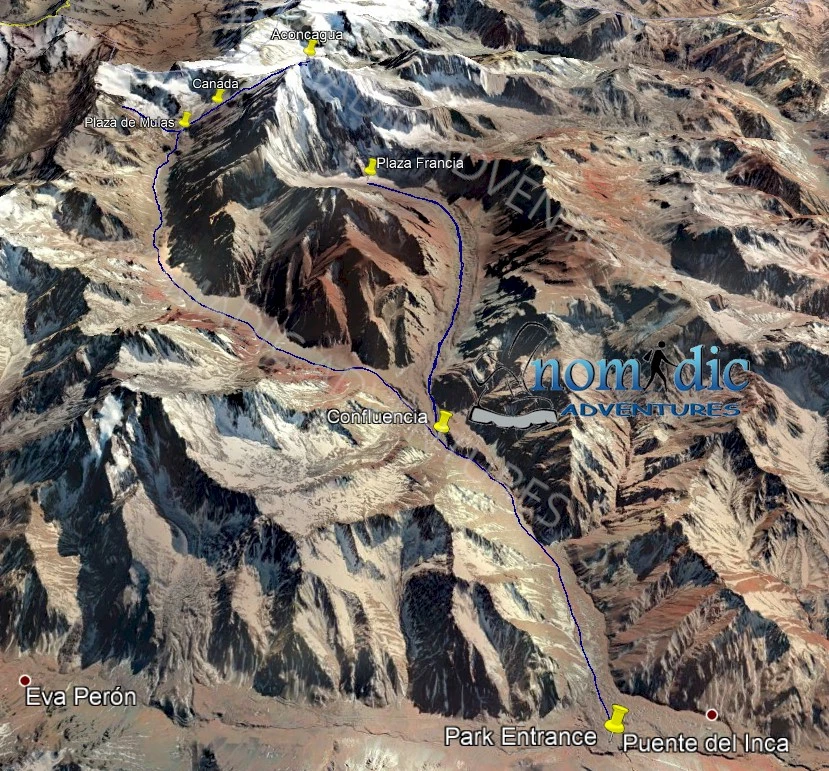 DAY 1 – MENDOZA (760m)
DAY 1 – MENDOZA (760m)
Upon arrival in Mendoza, team members will enjoy the comforts of one of the best hotels in the city. At the time noted in your confirmation letter, we will host an orientation meeting. At this meeting, we will perform a comprehensive gear check, an overview of the entire climb, and answer all questions. Guides will assist you with any gear rentals or purchases, if required. For the evening, you will be free to walk the streets of Mendoza and enjoy the many great restaurants in the area (meals not included).
DAY 2 – MENDOZA / PENITENTES (2,725m)
After registration with Aconcagua Provincial Park, we drive to Penitentes to start our acclimatization. Upon reaching Penitentes we will check in to our quaint hotel at the base of the mountain and have lunch. In the afternoon, staff will prepare the mule’s loads at our depot at Los Puquios for the following day. (B, L, D)
DAY 3 – PENITENTES / CONFLUENCIA (3,300m)
After breakfast, we take a short drive in a private van to the entrance of the park where we will present permits and begin our 3.5-hour trek to Confluencia Camp (3,300 m). We have light backpacks and the walking is on a well-worn, picturesque trail. Upon arrival to Confluencia you will be greeted by the staff with some refreshments and a tour of camp. After a good rest, staff will set up tents and take some time to explore the surrounding area and view the beautiful rock formations. The group will spend two nights in Confluencia with full meals and hot drinks available throughout the day. It is a lovely camp and our staff is there to assist you. (B, PL, D)
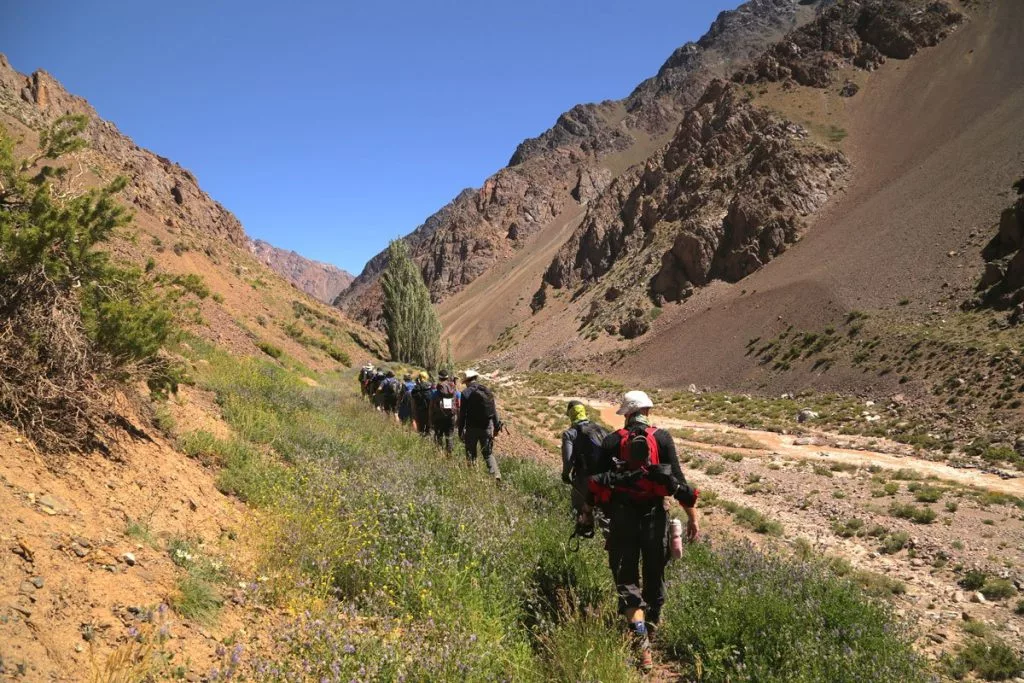
DAY 4 – CONFLUENCIA / PLAZA FRANCIA (4,000m) / CONFLUENCIA
Today we trek to Plaza Francia and back to Confluencia. At Plaza Francia, we will eat lunch and view the spectacular South Face of Aconcagua while further acclimatizing. The South Face of Aconcagua is famous for its difficult ascents, where many of the best climbers in the world come to test their skills. After exploring the area, we descend back to Confluencia Camp for the night. Six to seven hours (B, PL, D)
DAY 5 – CONFLUENCIA / PLAZA DE MULAS (4,260m)
We make our way to Plaza de Mulas Base Camp (seven to nine-hour trek). Guides ensure we walk at a moderate pace so everyone arrives feeling well. The trek follows the Horcones Superior River and then rises up onto a lateral moraine next to the Horcones Glacier. Upon arrival, team members can relax in the dining tent with hot drinks and snacks. Our Base Camp is a full-service camp, complete with full meals and Wi-Fi. Hot showers are available upon request. Seven to nine hours. (B, PL, D)
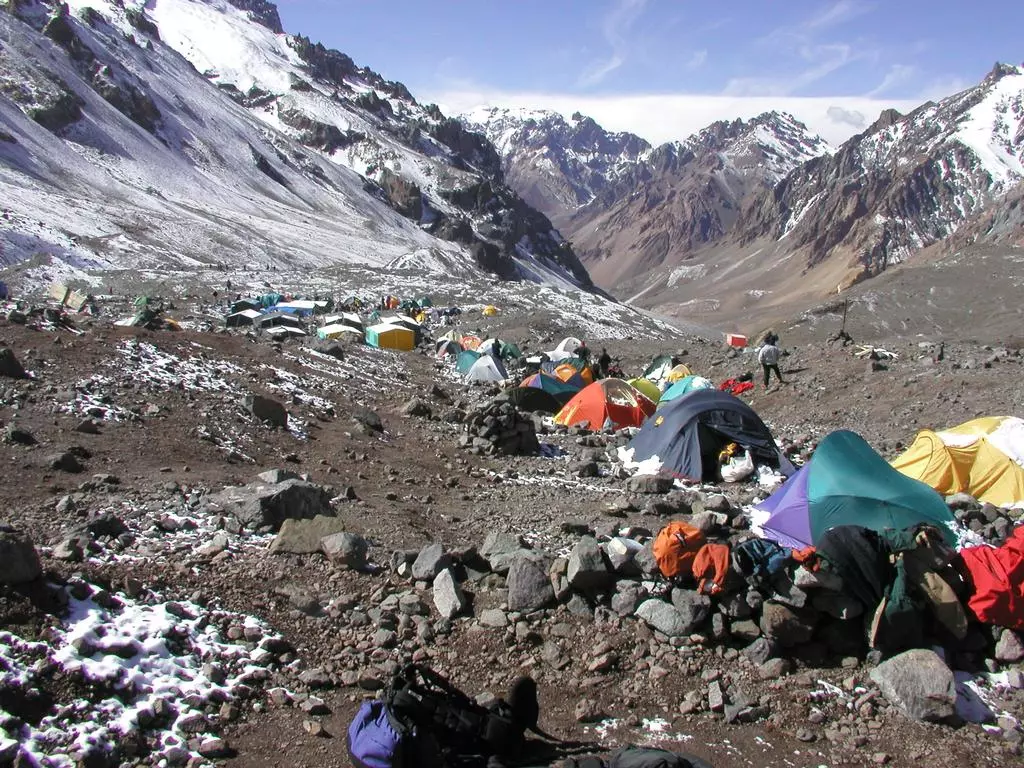
DAY 6 – PLAZA DE MULAS
Rest day. This will be a leisure day starting with a good breakfast, and then a nice walk in the surrounding area, which has many stunning vistas. In the afternoon, we will have an orientation and then prepare our gear for the next day’s climb of Mt. Bonete at 5,100 m. (B, L, D)
DAY 7 – PLAZA DE MULAS / MT. BONETE (5,100m) / PLAZA DE MULAS
This is an exciting day as we climb Mt Bonete, 5,100 m. For many climbers, this will be their first summit over 5,000 m. From the top there are great vistas of Aconcagua and the surrounding mountains. The climb of Mt. Bonete also gives team members essential acclimatization experience, which will be necessary to climb Aconcagua. Following our climb, we will return to Plaza de Mulas and enjoy a nice evening in Base Camp. six to seven hours. (B, PL, D)
DAY 8 – PLAZA DE MULAS / CAMP 1 “CANADÁ” (4,910m) / PLAZA DE MULAS
Acclimatization trek to Camp 1, or Camp Canadá. We will carry food, fuel, and other supplies to use in camps higher on the mountain. This walk begins through a field in Penitentes, with two- to five-foot tall pinnacles of ice, and then follows switchbacks that lead us steadily up to Camp Canadá. Once we reach camp, we will cache our gear, have a packed lunch, and then return to Base Camp. Three to four hours. (B, PL, D)
DAY 9 – PLAZA DE MULAS
Rest and acclimatization day. On this day team members will make sure that equipment is ready and all are well-rested to make the move to a camp higher up the mountain. (B, L, D)
DAY 10 – PLAZA DE MULAS / CAMP 1 “CANADÁ”
This morning we will move to Camp Canadá. Team members will carry personal gear and additional supplies. Porters will carry sleeping tents. Once at Canadá, the group will enjoy lunch and set up tents. Three to four hours. (B, PL, D)
DAY 11 – CAMP 1 “CANADÁ” / CAMP 2 “NIDO DE CÓNDORES” (5,250m)
Today we move from Camp Canada to our Camp 2, or “Nido de Cóndores,” where we will spend the next three nights for rest and acclimatization. On this day, each climber will be responsible for carrying personal equipment only. Porter staff will carry expedition equipment, food, and sleeping tents. After reaching Nido de Cóndores, we will set up tents with the guides and move our sleeping gear inside before settling down for the night. Guides will serve dinner in tents. three to four hours. (B, PL, D)
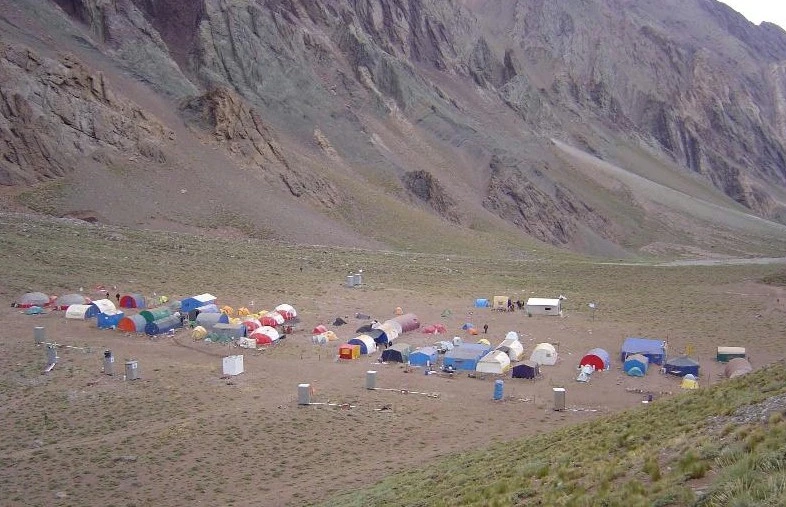
DAY 12 – CAMP 2 “NIDO DE CÓNDORES”
Today is a rest day and an opportunity to further acclimatize and enjoy the comfort of our camp. Resting on this day will improve your performance on summit day and greatly increase your chances for successfully reaching the summit. (B, L, D)
DAY 13 – CAMP 2 “NIDO DE CÓNDORES” / CAMP 3 “CÓLERA” (6,000m) / CAMP 2 “NIDO DE CÓNDORES”
Carry to High Camp, or “Camp Cólera.” All climbers will carry expedition food, fuel, and some camp equipment that we will need in Cólera and for our summit attempt. This will be a short hike, but we will move slowly to acclimatize and prepare for summit day. Once at Cólera, you will have lunch and then return to Nido de Cóndores. Four hours. (B, PL, D)
DAY 14 – CAMP 2 “NIDO DE CÓNDORES” / CAMP 3 “CÓLERA”
Climb to Camp 3, “Cólera.” We will carry our personal equipment and any extra gear needed for the summit attempt. Porters will carry sleeping tents. At Cólera Camp, staff will strategically position the campsite for protection in case of high winds. While climbers rest, guides will check each team member’s summit gear for the next day and give an orientation on the summit climb. We will have an early dinner and go to bed to get a good night’s rest for the early morning start the next day. Three hours. (B, PL, D)
DAY 15 – CAMP 3 “CÓLERA” / SUMMIT (6,962m) / CAMP 3 “CÓLERA”
Climb from Cólera to the summit and return to Camp 3.
We will wake up early in the morning and dress for our summit attempt. Guides will serve hot drinks and a quick breakfast. They will let us know what time to leave our tents so we all rise together and start moving toward the summit. This keeps us warm and moving together as a team. The climb is gradual as we follow switchbacks for two hours until we reach a small A-frame hut called “Independencia.” From here we will traverse across the North Face of Aconcagua until we reach the Canaleta, a low-angle gully that leads us up towards the summit ridge. As we ascend the Canaleta, we can look down on the surrounding mountains, which begin to drop away from as we go higher. A few hundred meters below the summit, the route traverses east and leads us directly the summit! A cross proudly stands on top to mark the summit. There is plenty of room for everybody to take personal and group photos. It is a time for celebration! Time of day and the weather often determine the amount of time we spend on the summit. After we’ve all taken photos and absorbed the views, we will begin our descent back to Cólera Camp. eight to twelve hours. (B, PL, D)
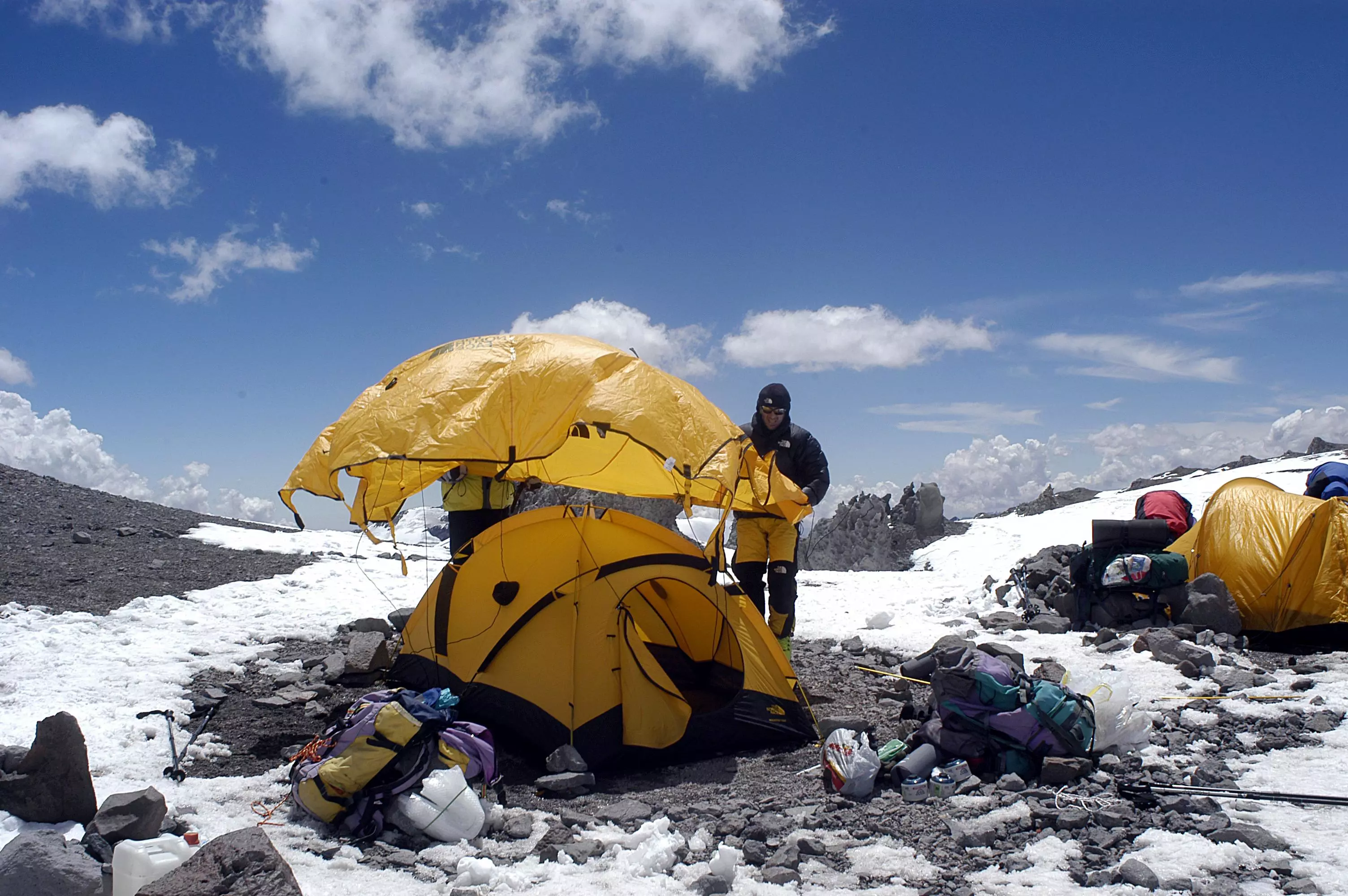
DAY 16 – CAMP 3 “CÓLERA”/ PLAZA DE MULAS
We head down to Plaza de Mulas Base Camp. We will take our time moving downhill with our climbing equipment and personal gear. Porters will carry sleeping tents and human waste. Once in Plaza de Mulas, the group will have the rest of the day free to celebrate our climbing experience and enjoy a great meal. Four hours. (B, PL, D)
DAY 17 – PLAZA DE MULAS / HORCONES / MENDOZA
We descend to Horcones, the entrance to the Park, on the last trekking day of the expedition. Mules will carry belongings so team members will only take light backpacks with jackets and packed lunches. Transfer to Mendoza City. Lodge in the hotel. Guides and climbers often get together for dinner to celebrate the climb. Six to seven hours. (B, PL) (Mendoza dinner not included)
DAY 18 – MENDOZA
Breakfast. End of services. (B)
DAY 19 – EXTRA DAY
Extra day for weather.
DAY 20 – EXTRA DAY
Extra day for weather.
NOTE: THE ABOVE ITINERARY IS INTENDED AS A GUIDELINE ONLY. ALTHOUGH EVERY EFFORT WILL BE MADE TO ADHERE TO IT, CHANGES MAY BE CAUSED DUE TO WEATHER CONDITIONS, TRANSPORT FAILURE, OR OTHER UNFORESEEN EVENTS. PLEASE BE FLEXIBLE IF NECESSARY.
End of services
Everest Base Camp or Advanced Base Camp
We are often asked which is the better of the two treks, Everest
advanced base camp from Tibet (north side) or Everest base camp from
Nepal (south side). It really is not an easy question to answer as it
all depends on what you are hoping to get out of the trek. Advanced
Everest Base Camp - 6340m Tibet … Continue reading
KEEPING YOUR CELL PHONE ALIVE ON at altitude
Well the answer is quite simple – snuggle up with all of your batteries
at night or as soon as the temperatures drop. Packing a spars pair of
warm thermal and mohair socks will go a long way to creating a nice warm
package for all of your batteries. Continue reading


